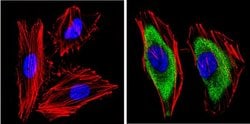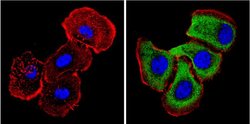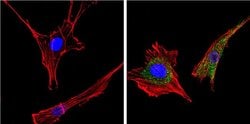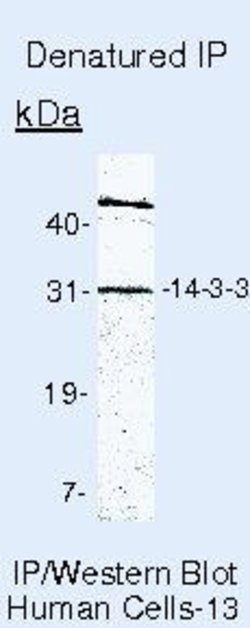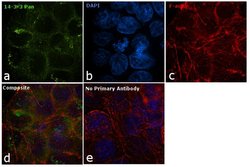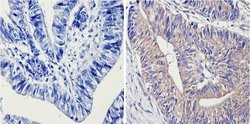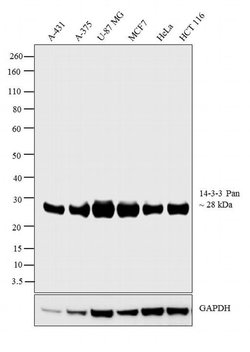Promotional price valid on web orders only. Your contract pricing may differ. Interested in signing up for a dedicated account number?
Learn More
Learn More
14-3-3 Pan Monoclonal Antibody (CG15), Invitrogen™
Mouse Monoclonal Antibody
Supplier: Thermo Scientific MA512242
Description
MA5-12242 targets 14.3.3 pan in IP, ICC/IF, IHC (P) and WB applications and shows reactivity with Human and Mouse samples. The MA5-12242 immunogen is 14-3-3 gamma recombinant human protein.
At least seven isoforms comprise the highly conserved 14-3-3 family of homo- and heterodimeric proteins that are abundantly expressed in all eukaryotic cells. Although more than seven isoforms of 14-3-3 have been described, some redundancies have appeared upon sequencing. The 14-3-3s are thought to be key regulators of signal transduction events mediated through their binding to serine-phosphorylated proteins. By interacting with Cdc25C, 14-3-3 regulates entry into the cell cycle and, through interaction with Bad, prevents apoptosis. Other proteins that have been shown to bind to 14-3-3s include members of the protein kinase C family, Cbl, IRS-1, polyoma middle-T antigen, nitrate reductase, S-raf and the IGF-1 receptor. Detection of 14-3-3 proteins in cerebrospinal fluid has been shown to be quite useful in the differential diagnosis of Creutzfeldt-Jakob disease and other prion diseases.
Specifications
| 14-3-3 Pan | |
| Monoclonal | |
| 0.2 mg/mL | |
| PBS with 0.2% BSA and 0.09% sodium azide; pH 7.4 | |
| O70456, P27348, P31946, P31947, P61981, P61982, P62258, P62259, P63101, P63104, P68254, Q9CQV8 | |
| Sfn, YWHAB, YWHAE, YWHAG, YWHAQ, YWHAZ | |
| 14-3-3 gamma recombinant human protein | |
| 500 μL | |
| Primary | |
| Human, Mouse | |
| Antibody | |
| IgG1 κ |
| Immunocytochemistry, Immunohistochemistry (Paraffin), Immunoprecipitation, Western Blot | |
| CG15 | |
| Unconjugated | |
| YWHAG | |
| 1110013I11Rik; 1300003C17Rik; 14-3-3; 14-3-3 alpha; 14-3-3 beta; 14-3-3 delta; 14-3-3 epsilon; 14-3-3 gamma; 14-3-3 protein beta; 14-3-3 protein beta/alpha; 14-3-3 protein beta/alpha, N-terminally processed; 14-3-3 protein beta/alpha-A; 14-3-3 protein beta/alpha-B; 14-3-3 protein beta-subtype; 14-3-3 protein epsilon; 14-3-3 protein gamma; 14-3-3 protein gamma subtype; 14-3-3 protein gamma, N-terminally processed; 14-3-3 protein gamma-A; 14-3-3 protein gamma-B; 14-3-3 protein gamma-subtype; 14-3-3 protein sigma; 14-3-3 protein tau; 14-3-3 protein T-cell; 14-3-3 protein theta; 14-3-3 protein zeta; 14-3-3 protein zeta/delta; 14-3-3 protein/cytosolic phospholipase A2; 14-3-3 sigma; 14-3-3 sigma protein; 14-3-3 tau; 14-3-3 theta; 14-3-3 zeta; 14-3-3beta; 14-3-3d; 14-3-3E; 14-3-3G; 14-3-3gamma; 14-3-3-like protein; 14-3-3t; 14-3-3z; 14-3-3zeta; 14-3-3-zeta; 1C5; 2700028P07Rik; 3-monooxgenase/tryptophan 5-monooxgenase activation protein, gamma polypeptide; 3-monooxgenase/tryptophan 5-monooxygenase activation protein, gamma polypeptide; 3-monooxygenase/tryptophan 5 monooxygenase activation protein beta polypeptide; 3-monooxygenase/tryptophan 5-monooxgenase activation protein gamma polypeptide; 3-monooxygenase/tryptophan 5-monooxygenase activation protein, gamma polypeptide; AA409740; AI596267; AL022924; AU019196; AU020854; AU021156; brain protein 14-3-3, beta isoform; D7Bwg1348e; epididymis luminal protein 2; epididymis luminal protein 4; epididymis secretory protein Li 1; epididymis secretory protein Li 3; epididymis secretory protein Li 93; epithelial cell marker protein 1; Er; factor activating exoenzyme S; FAS; GW128; HEL2; HEL4; HEL-S-1; HEL-S-3; HEL-S-93; HME1; HS1; KCIP-1; MDCR; MDS; mitochondrial import stimulation factor (MSF) L subunit; mitochondrial import stimulation factor L subunit; Mitochondrial import stimulation factor S1 subunit; Mkrn3; Mme1; MSF L; Msfs1; phospholipase A2; PPP1R170; prepronerve growth factor RNH-1; Protein 1054; Protein HS1; Protein kinase C inhibitor protein 1; protein kinase C inhibitor protein-1; protein phosphatase 1, regulatory subunit 170; protein tau; protein, theta; R74690; SEZ-2; SFN; Stratifin; tryosine 3-monooxgenase/tryptophan 5 monooxgenase activation protein gamma; tryosine 3-monooxgenase/tryptophan 5-monooxgenase activation protein gamma polypeptide; tryosine 3-monooxygenase/tryptophan 5-monooxygenase activation protein beta polypeptide; tryosine 3-monooxygenase/tryptophan 5-monooxygenase activation protein gamma; tyrosine 3/tryptophan 5 -monooxygenase activation protein beta polypeptide; tyrosine 3/tryptophan 5 -monooxygenase activation protein gamma polypeptide; tyrosine 3/tryptophan 5 -monooxygenase activation protein, beta polypeptide; tyrosine 3/tryptophan 5 -monooxygenase activation protein, epsilon polypeptide; tyrosine 3/tryptophan 5 -monooxygenase activation protein, gamma polypeptide; tyrosine 3/tryptophan 5 -monooxygenase activation protein, theta polypeptide; tyrosine 3/tryptophan 5 -monooxygenase activation protein, zeta polypeptide; tyrosine 3-monooxgenase/tryptophan 5 monooxgenase activation protein beta polypeptide; tyrosine 3-monooxgenase/tryptophan 5 monooxgenase activation protein, beta polypeptide; tyrosine 3-monooxgenase/tryptophan 5-monooxgenase activation protein, beta polypeptide; tyrosine 3-monooxgenase/tryptophan 5-monooxgenase activation protein, gamma polypeptide; tyrosine 3-monooxygenase/tryptophan 5-monooxygenase activation protein beta; tyrosine 3-monooxygenase/tryptophan 5-monooxygenase activation protein beta L homeolog; tyrosine 3-monooxygenase/tryptophan 5-monooxygenase activation protein beta S homeolog; tyrosine 3-monooxygenase/tryptophan 5-monooxygenase activation protein epsilon; tyrosine 3-monooxygenase/tryptophan 5-monooxygenase activation protein gamma; tyrosine 3-monooxygenase/tryptophan 5-monooxygenase activation protein gamma L homeolog; tyrosine 3-monooxygenase/tryptophan 5-monooxygenase activation protein gamma S homeolog | |
| Mouse | |
| Protein G | |
| RUO | |
| 10971, 22627, 22628, 22630, 22631, 2810, 54401, 55948, 7529, 7531, 7532, 7534 | |
| 4° C | |
| Liquid |
Product Content Correction
Your input is important to us. Please complete this form to provide feedback related to the content on this product.
Product Title
Spot an opportunity for improvement?Share a Content Correction
